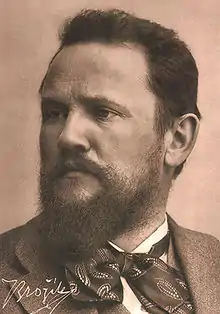Václav Brožík
Václav Brožík (pronounced [vɑ:tslaf br̩oʒiːk]; 6 March 1851, Třemošná – 15 April 1901 Paris) was a Czech painter who worked in the academic style.
Václav Brožík | |
|---|---|
 Václav Brožík | |
| Born | 6 March 1851 |
| Died | 15 April 1901 (aged 50) |
| Nationality | Czech |
| Education | Academy of Fine Arts in Prague |
| Known for | Painting |
| Notable work | Jan Hus before the Council of Constance (1883) Tu Felix Austria Nube (1886) |
| Movement | Academicism |
| Spouse | Hermine Sedelmayer |
| Awards | Gold medal winner at the Salon (1878) Legion of Honour (1884) Ennobled by Emperor Franz Joseph I (1887) |
| Elected | Institut de France (1896) |
Life
He came from a poor family, studying lithography and porcelain painting through apprenticeships. Beginning in 1868, with financial assistance from a local landowner, he was able to attend the Academy of Fine Arts in Prague. He made a trip to the Netherlands, where he studied the Old Masters, then settled in Paris (despite not being able to speak French), where a letter of recommendation assured him the support of Jaroslav Čermák. In 1879 he married Hermina Sedelmeyer, daughter of the wealthy Parisian art dealer Charles Sedelmeyer.[1] For most of his life, he divided his time between Paris and Prague, where he became a Professor at the Art Academy in 1893.
He was named a member of the Institut de France, partly through the influence of his father-in-law, who also suggested that he do a painting on the theme "Tu Felix Austria Nube" (from an old saying: "Let others wage war: thou, happy Austria, marry").[2] The result pleased Emperor Franz Joseph I, who was involved in an unhappy marriage. As a result, Brožík was elevated to the nobility.[1]
He also became a member of the Académie des Beaux-Arts, received the Grand Cross of the Légion d'Honneur[3] and was appointed to the Czech Academy of Arts and Sciences.[4] One of his 1884 paintings, showing Columbus soliciting the aid of Queen Isabella, appeared on a United States postage stamp in 1893.[5] [6]
His health began to decline in 1894, but he threw himself into painting even more diligently. He died suddenly of heart failure in 1901 and was buried in Montmartre.[1] Appreciation of his work suffered a serious decline after his death, as it was considered old-fashioned, but a major retrospective in 2003 has created some renewed interest.
References
- 4 pictures and biography at Art Renewal Center
- "The World of the Habsburgs: Tu Felix Austria Nube in context". Die Welt der Habsburger.
- Kdo byl kdo v našich dějinách do roku 1918, by Pavel Augusta. Libri, Prague (1998) p.54 ISBN 80-8598-306-0
- Šlechtová, Alena and Levora, Josef: Členové České akademie věd a umění 1890–1952, 2nd edition, Academia Prague (2004) ISBN 80-200-1066-1
- "Gerhard Batz: Das erste Kunstwerk eines tschechischen Künstlers auf Briefmarken (United States postage stamp based on a painting by Brožík)". batz-hausen.de.
- "About U.S. Stamps: Columbian Exposition Issues (1893)". Smithsonian Institution's National Postal Museum.
Further reading
 Works by or about Václav Brožík at Wikisource
Works by or about Václav Brožík at Wikisource- Osobnosti - Česko : Ottův slovník (Well-known Czechs from Otto's encyclopedia) Ottovo nakladatelství, Prague (2008) ISBN 978-80-7360-796-8
- Vošahlíková, Pavla: Biografický slovník českých zemí, Libri, Prague (2007) ISBN 978-80-7277-248-3
External links
- Works by or about Václav Brožík at Internet Archive
- Slovensko-Česky Klub: Brožík Retrospective
- Novinky: Brožíkův návrat na výsluní (Brožik's Comeback) by Peter Kováč
- Radio Prague: Pražská výstava obrazů Václava Brožíka končí už příští týden (Brožík's Retrospective Ends Next Week) by Evelina Himalová (2003)
.jpg.webp)